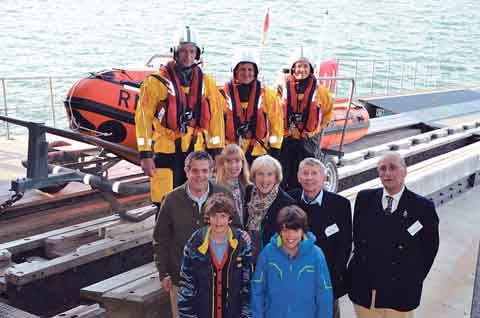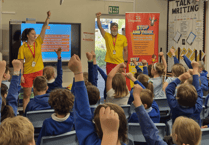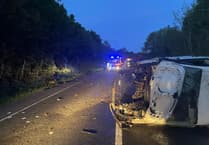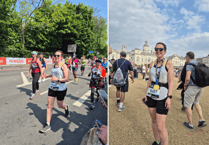RNLI Angle's new £41,000 inshore lifeboat was officially named and dedicated at a champagne ceremony last Thursday evening..
The D class lifeboat SuperG II (D-776) has been funded by The Coward Endowment, a small family trust established by the late Charles Coward in 1965.
The new lifeboat was officially handed over to the RNLI by Charles Coward's son, Clive, of London. He was accompanied by his wife Frances; daughter and son-in-law, Tammy and Zino Pece, of Swansea, and grandsons Oli and Tom Pece.
Indeed, it is Oli and Tom who are the inspiration for the lifeboat's name - 'SuperG' (Super Grandad) being their name for grandad Clive.
Mr. Coward said that, although The Coward Endowment mainly supports small charities, the exception to this is the RNLI because the trustees believe the lifesaving charity does such valuable work.
The trustees are particularly impressed by the courage and dedication of RNLI volunteers.
"The funding of the new inshore lifeboat is a significant gift for the trust and the trustees are excited about the opportunity to provide something so tangible for the RNLI's volunteers at Angle," he said.
He praised the work of the RNLI, whose volunteers placed their own lives on the line every time they go to sea to save others. He was delighted that the new lifeboat was at a location with which they could identify – 'just along the road' from the home of their daughter, son-in-law and grandsons at Swansea. Tammy is a graduate of Swansea University.
The new lifeboat is the second craft to be donated to the RNLI by The Coward Endowment. SuperG I is a rescue water craft in service with RNLI Lifeguards at Bournemouth.
Earlier in the day, the family had joined coxswain Lewis Creese and the crew of Angle's all-weather Tamar class lifeboat Mark Mason on a training exercise on the Milford Haven Waterway.
The new inshore lifeboat was accepted, on behalf of the RNLI, by Rear Admiral Mark Kerr, DL, RN, a member of the charity's council. He then handed her into the care of Angle lifeboat station.
Admiral Kerr spoke of the work of the RNLI and said it costs around £385,000 a day to run the lifesaving charity, all of which is generously donated by the public.
"Lifesaving couldn't happen without all the fundraising support," he said.
The RNLI is independent of Coastguard and Government and depends on voluntary donations and legacies to maintain its rescue service. Last year, lifeboats around the UK and the Republic of Ireland launched on over 8,500 occasions, rescuing over 8,000 people and saving over 300 lives.
In accepting SuperG II, on behalf of the station, lifeboat operations manager, John Allen-Mirehouse, paid tribute to The Coward Endowment for their significant gift.
"It is a proud and satisfying moment to receive this new lifeboat for the Angle station," he said.
Before Mrs. Frances Coward formally named the new lifeboat with a bottle of champagne, a service of dedication was led by the Rev. Geoffrey Howell, Team Vicar for the Monkton Rectorial Benefice. Particularly poignant was the singing of the Seafarers' hymn, 'Eternal Father, Strong to Save'.
Present at the ceremony was the RNLI's divisional operations manager Nigel Jones, and among the guests were representatives of neighbouring lifeboat stations at Little Haven, St. Davids and Tenby, and Pembroke Ladies Lifeboat Guild members, who made the catering arrangements.
Afterwards, SuperG II, crewed by Adam Stringer (helmsman), Sarah Lunn and David Dillane, was launched and gave a short display off the lifeboat station.
The new lifeboat succeeds the D class Richard John Talbot Hillier (D-638), which was at Angle for 10 years and gave sterling service. She has now been transferred to RNLI Barry Dock as a boarding boat.
The D class inshore lifeboats have been the workhorses of the RNLI since 1963. They are fast, light and highly manoeuvrable and usually operate closer to the shore than all-weather lifeboats. They are specifically suited to surf, shallow water and confined locations, often close to cliffs, among rocks or even in caves.
The 5m long lifeboats each have a crew of two to three, and the single 50hp outboard engine gives them a maximum speed of 25 knots. They have a range of three hours at their maximum speed.
The design of the class has continued to evolve since its introduction and the latest version was introduced in 2003. Equipment includes both fitted and hand-held VHF radio, night-vision equipment and first aid kits, including oxygen.





Comments
This article has no comments yet. Be the first to leave a comment.